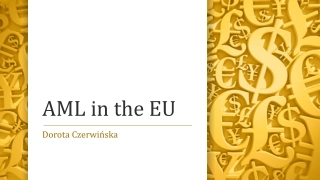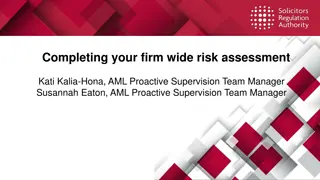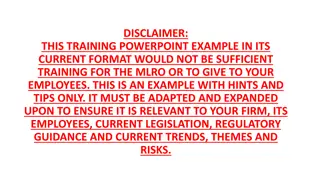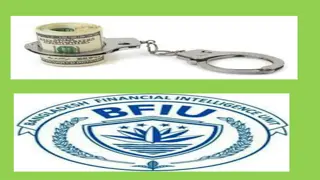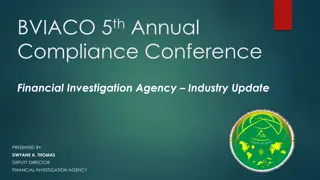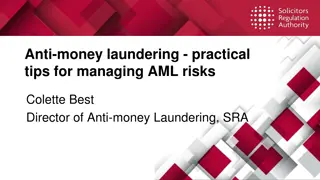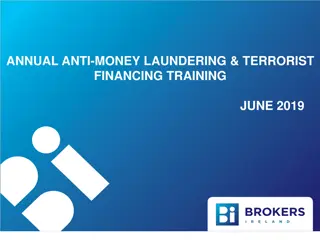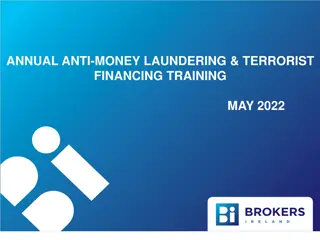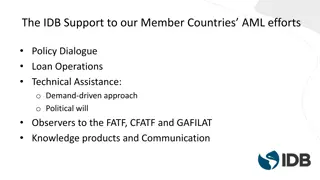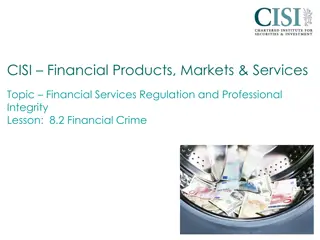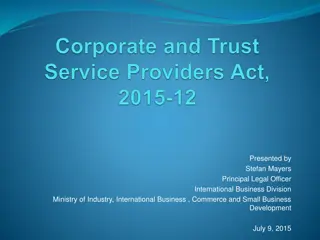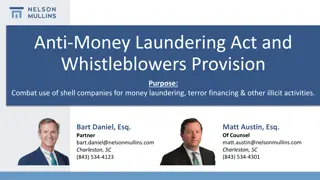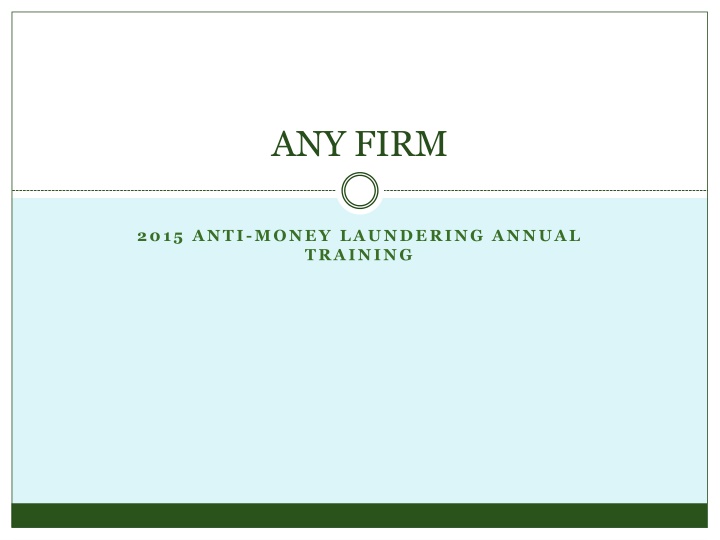
ANY FIRM 2015 Anti-Money Laundering Training
The content discusses ANY FIRM's commitment to ethical standards and compliance with AML regulations. It covers the Bank Secrecy Act, USA PATRIOT Act, AML policy objectives, and stages of money laundering. Additionally, it explores the Bank Secrecy Act and the USA PATRIOT Act, explaining their significance in combating financial crimes like money laundering. Furthermore, it touches on terrorist financing and the importance of preventing illegal activities.
Download Presentation

Please find below an Image/Link to download the presentation.
The content on the website is provided AS IS for your information and personal use only. It may not be sold, licensed, or shared on other websites without obtaining consent from the author. If you encounter any issues during the download, it is possible that the publisher has removed the file from their server.
You are allowed to download the files provided on this website for personal or commercial use, subject to the condition that they are used lawfully. All files are the property of their respective owners.
The content on the website is provided AS IS for your information and personal use only. It may not be sold, licensed, or shared on other websites without obtaining consent from the author.
E N D
Presentation Transcript
ANY FIRM 2015 ANTI-MONEY LAUNDERING ANNUAL TRAINING
AML Firm Policy Statement ANY FIRM ( ANY FIRM ) is committed to conducting business with the highest ethical standards and in full compliance with the Bank Secrecy Act, USA PATRIOT Act and other related AML regulations and statutes. While ANY FIRM s AML program is administered by the Compliance Department, responsibility for compliance with this policy is the responsibility of all ANY FIRM associates. To that end, knowingly violating this policy may constitute a cause for immediate dismissal; as well as, referral to government authorities.
ANY FIRM AML Firm Policy Objectives ANY FIRM s AML Policy has the following objectives: To protect the name, reputation and financial soundness of ANY FIRM . To prevent unintentional or inadvertent participation in illegal activities. To comply with all appropriate rules and regulations including, but not limited to the USA PATRIOT Act, the Bank Secrecy Act & OFAC regulatory requirements; and To act as a resource for ANY FIRM associates on AML matters. ANY FIRM management will assure that the AML compliance program is implemented and followed throughout the firm.
Bank Secrecy Act and the USA PATRIOT Act What is the Bank Secrecy Act? The Bank Secrecy Act (BSA) is a family of laws enacted to fight money laundering and other financial crimes by creating a paper trail to trace dirty money throughout the banking system. What is the USA PATRIOT Act? The USA PATRIOT Act (Uniting and Strengthening America by Providing Appropriate Tools Required to Intercept and Obstruct Terrorism). The USA Patriot Act was enacted into law after September 11, 2001, to make it easier to fight money laundering and the financing of terrorism.
Three Stages of Money Laundering Money launderers operate around the world, and funds may be laundered through many different types of financial institutions such as investment banks, brokerages, commercial and retail banks, private equity firms and hedge funds. Generally, money laundering occurs in three stages. Cash first enters the financial system at the "placement" stage, where the cash generated from criminal activities is converted into monetary instruments, such as money orders or traveler's checks, or deposited into accounts at financial institutions. At the "layering" stage, the funds are transferred or moved into other accounts or other financial institutions to further separate the money from its criminal origin. At the "integration" stage, the funds are reintroduced into the economy and used to purchase legitimate assets or to fund other criminal activities or legitimate businesses.
Terrorist Financing Terrorist financing may not involve the proceeds of criminal conduct, but rather an attempt to conceal either the origin of the funds or their intended use, which could be for criminal purposes. Legitimate sources of funds are a key difference between terrorist financiers and traditional criminal organizations. In addition to charitable donations, legitimate sources include foreign government sponsors, business ownership and personal employment. Although the motivation differs between traditional money launderers and terrorist financiers, the actual methods used to fund terrorist operations can be the same as or similar to methods used by other criminals to launder funds. Funding for terrorist attacks does not always require large sums of money and the associated transactions may not be complex.
Customer Identification Program ANY FIRM has established, documented, and maintains a written Customer Identification Program (CIP). The firm will collect certain minimum customer identification information from each customer who opens an account; utilize risk-based measures to verify the identity of each customer who opens an account; record customer identification information and the verification methods and results; provide the required adequate CIP notice to customers that the firm will seek identification information to verify their identities; and compare customer identification information with government-provided lists of suspected terrorists, once such lists have been issued by the government. The firm will use documentary methods to form a reasonable belief to identify the customer. Circumstances in which a client cannot provide documentary evidence of identification, ANY FIRM may use non-documentary methods. For a complete description of these methods, please refer to ANY FIRM s Compliance Manual.
Required Customer Identification Information Governments and regulators worldwide require financial institutions to obtain specific information concerning a customer s identity as part of the account opening process. These requirements exist to enable the firm to form a reasonable belief that it knows the true identity of its customers. Regardless of whether illegal activity occurs in an account, failure to adhere to client identification requirements could expose the Firm to regulatory scrutiny, including possible fines and penalties. Prior to opening an account for a new customer, you must obtain certain minimum client identification information, such as: Entities: name, principal place of business and government issued identification number, and documentation certifying the existence of the business, such as a business license or articles of incorporation. Individuals: name, date of birth, physical address and government issued identification number (social security number) If the minimum information is not provided the account will not be opened. For complete CIP information please refer to the Compliance Manual.
Required Customer Identification Information recordkeeping The Firm will retain the identifying information obtained at account opening for a period of six (6) years after the account is closed. The Firm must also keep a description of the following for five years after the record was made: Any document that was relied on to verify identity, noting the type of document, the identification number, the place of issuance, and if any, the date of issuance and expiration date. The method and results of any measures undertaken to verify identity. The results of any substantive discrepancy discovered when verifying identity. .
COMPARISON WITH GOVERNMENT LIST At such time as the Firm receives notice that a federal government agency has issued a list of known or suspected terrorists and identified the list as a list for CIP purposes, the Firm will, within a reasonable period of time after an account is opened (or earlier, if required by another federal law or regulation or federal directive issued in conjunction with an applicable list), determine whether a customer appears on any such list of known or suspected terrorists or terrorist organizations issued by any federal government agency and designated as such by the Treasury Department in consultation with the federal functional regulators. The Firm will follow all federal directives issued in conjunction with such lists.
CIP Notice to Customers The CIP rule requires ANY FIRM to provide adequate notice to customers that ANY FIRM is requesting information from them to verify their identities. Important Information About Procedures for Opening a New Account: To help the government fight the funding of terrorism and money laundering activities, Federal law requires all financial institutions to obtain, verify and record information that identifies each person who opens an account. What this means for you: When you open an account, we will ask you for your name, address, date of birth and other information that will allow us to identify you. We may also ask to see your driver s license or other identifying documents.
Know Your Customer (KYC) ANY FIRM has a responsibility to know the customers with whom it does or intends to do business. Therefore, in addition to information gathered for client identification and verification purposes, you must make efforts to know your customer by obtaining information relating to the client s financial resources and investment experience, as well as investment objectives/risk tolerance and anticipated business activities. This information will better enable you to understand your client s business and the types of transactions in which the client is likely to engage, which will in turn help you to spot unusual or potentially suspicious activity.
Prohibited Accounts and Cash Acceptance Policy ANY FIRM prohibits the deposit of Bearer Bonds or Bearer Shares. These instruments provide an extremely high level of anonymity and confidentiality that hides the true identity of the beneficial owner and as a result, can pose a high-risk to ANY FIRM due to the lack of control over required Know Your Customer and Customer Identification Program practices. ANY FIRM prohibits the opening of Foreign Private Banking accounts; defined as an account (or any combination of accounts) that requires a minimum aggregate deposit of$1,000,000.00, is established for one or more individuals, and is assigned to or administered or managed by, in whole, or in part, an officer, employee, or agent of a financial institution acting as a liaison between financial institution and the direct or beneficial owner of the account. ANY FIRM does not accept cash deposits or cash equivalents.
Recognizing Suspicious Activity As the first line of defense, in identifying and reporting suspected money laundering, you should be aware of red flags that may indicate money laundering. Red flags can happen when opening new accounts or during the life of the account. Your assistance and knowledge can be very important in identifying possible suspicious activity. Depending on your function, you may be positioned to spot unusual patterns of account activity. Do not rely solely on the list of red flags to help you recognize unusual activity. Use your common sense, experience and knowledge to assess suspicious activity. While unusual activity alone is not necessarily suspicious, it does indicate that additional research and follow-up is needed. If you spot unusual activity contact the Compliance AML Group.
Red Flags Wire Fraud and Money Transfers There are an increasing number of reports in the industry of efforts to perpetrate wire fraud against customers whose email accounts have been compromised. Therefore, it is imperative to exercise extreme caution when dealing with clients via email, even if the client has a history of communicating through this medium. If a request for a third party transaction is received via email an outgoing phone call to confirm must be placed. Some Red Flags to be aware of: As in other phishing scams, spelling and grammar in the emails is often poor There is occasionally an indication that the need for the funds is urgent Wire requests may be international, but domestic requests are also becoming common The scammers generally prefer to only communicate via email, occasionally claiming that they cannot access a phone or visit in person Transaction does not make sense based on what you know about the client
Red Flags At account Opening Customer discusses your record-keeping or reporting requirements with the apparent intention of avoiding them. Customer suggests paying a gratuity to an employee. Customer submits account documentation showing an unclear ownership structure. Customer furnishes unusual or suspicious identification documents or declines to produce originals for verification. Customer is unwilling to provide personal background information when opening an account. Customer s home or business telephone is disconnected. Customer does not wish a statement of his account or any mail sent to him. Customer asks many questions about how the financial institution disseminates information about the identification of its customers. A business customer is reluctant to reveal details about the business activities or to provide financial statements or documents about a related business entity. Customer tries to open an account without identification, references or complete local address
Red Flags Elder Financial Exploitation The National Center on Elder Abuse offers the following definition of exploitation as a type of elder abuse: the illegal taking, misuse, or concealment of funds, property, or assets of a vulnerable elder. As employees of ANY FIRM you may become aware of persons or entities conducting or attempting to conduct illicit activity against elderly clients. In many cases, your familiarity with their customers may lead to identification of possible suspicious activity that should be reported to the Compliance AML Compliance group for further review. The red flags noted below include both activity that may come to light through transactional review and through interactions with clients or their caregivers. This list is not all inclusive and should be used as a guideline to detect elder abuse:
Red Flags Elder Financial Exploitation Interactions with elder clients and caregivers: A caregiver or other individual shows excessive interest in the client s finances or assets, does not allow the elder client to speak for himself, or is reluctant to leave the client s side during conversations; The client shows an unusual degree of fear or submissiveness toward a caregiver, or expresses a fear of eviction or nursing home placement if money is not given to the caretaker; The registered representative is unable to contact and/or speak directly with the client, despite repeated attempts to contact him. A new caretaker, relative, or friend attempts to conduct financial transactions on behalf of the client without proper documentation; The client moves away from existing relationships and toward new associations with other friends or strangers; The client s financial management changes suddenly, such as through a change of power of attorney to a different family member or new individual; The client lacks knowledge about his or her financial status, or shows a sudden reluctance to discuss financial matters.
Red Flags Elder Financial Exploitation Erratic or unusual account transactions, or changes in patterns of behavior: Frequent large withdrawals, including daily maximum withdrawals from an ATM; Sudden non-sufficient fund activity; Uncharacteristic non-payment for trades, which may indicate a loss of funds or access to funds; Debit transactions that are inconsistent for the client; Uncharacteristic attempts to wire large sums of money; Termination of CD s or accounts without regard to penalties.
Red Flags Low Priced Securities A customer opens a new account and delivers physical certificates representing a large block of thinly-traded or low priced securities. A customer has a pattern of depositing physical share certificates, immediately selling the shares and then wiring out the proceeds of the resale. A customer deposits share certificates that are recently issued or represent a large percentage of the float for the security. Share certificates reference a company or customer name that has been changed or that does not match the name on the account. The lack of a restrictive legend on deposited shares seems inconsistent with the date the customer acquired the securities or the nature of the transaction in which the securities were acquired.
Red Flags Low Priced Securities There is a sudden spike in investor demand for, coupled with a rising price in, a thinly- traded or low priced security. The company was a shell company when it issued the shares. A customer with limited or no other assets under management at the Firm receives an electronic transfer or journal transaction of large amounts of low-priced, unlisted securities. The issuer s SEC filings are not current, are incomplete, or nonexistent. The issuer has been through several recent name changes, business combinations or recapitalizations, or the company s officers are also officers of numerous similar companies.
Suspicious Activity: What to Report Crimes or suspected crimes by individuals (whether associated with ANY FIRM , a client, or prospective client, employee or vendor) are required to be reported. This includes suspicion that the ANY FIRM is being used as a conduit for criminal activity such as money laundering or terrorist financing. ANY FIRM is required to report not only on money laundering and terrorist financing, but on the following examples of criminal activity: Bribery Securities Fraud Tax Evasion Check or Credit/Debit Card Fraud Insider Trading Market Manipulation Wire Fraud Wash or other fictitious trading Elder Abuse Low Priced Security Transactions Computer Intrusion Additionally, if ANY FIRM determines that a series of transactions that would not independently trigger ANY FIRM s suspicions, but that taken together form a suspicious pattern of activity, than the activity is reportable. Securities fraud is a crime that involves fraud, misrepresentation or the omission of material information in conjunction with the purchase or sale of securities. It can include offering fraud, Ponzi schemes, market manipulation and many other crimes.
Suspicious Activity: When to Report All potential suspicious/unusual activity should be reported as soon as possible to ANY FIRM s AML Compliance Officer. When reporting the activity, gather and provide the following maturity: The date the activity was identified Who identified the activity The date range for the activity The type of activity identified (excess wires, penny stock transactions, suspicious documents, Identity Theft, Privacy Issue, etc.) The account number(s) affected Any additional information necessary to conduct a review. All reports of suspected suspicious activity are and will remain confidential.
Willful Blindness Willful blindness occurs when a financial institution or individual deliberately ignores signs that an account is being used to launder money. When unusual activity is first noted employees should: Make a reasonable effort to acquire an explanation for the activity, such as contacting the client to inquire about the unusual transaction. Maintain notes of your conversation/research. Report any activity that appears suspicious to the AML Compliance Group. It is better to cry wolf then not. Report the activity as soon as possible even if you have no evidence that illegal activity is involved. You can be considered willfully blind even if you had no actual knowledge of the criminal activity, you did not profit from the criminal activity, and you did not purposefully participate in it.
Willful Blindness: Penalties The penalties for willful blindness can be as harsh as those imposed on the individual(s) conducting the money laundering. Penalties for facilitating or being willfully blind to money laundering activity are severe. ANY FIRM may impose fines or terminate your employment for failing to comply with anti-money laundering laws and regulations, or ANY FIRM s compliance policies. You may also face civil or criminal fines and imprisonment. Violators may face civil penalties of at least $10,000 or the value of the funds involved in the transaction, whichever is greater. Even if ANY FIRM enters into an agreement with the government to settle charges of violating AML laws, the government can still proceed against you as an individual. The Department of Treasury, the SEC and FINRA may impose significant penalties. Criminal penalties include fines and prison sentences.
Criminal Penalties for Money Laundering and Terrorist Financing Penalties for money laundering and terrorist financing can be severe. A person convicted of money laundering can face up to 20 years in prison and a fine of up to $500,000. Any property involved in a transaction or traceable to the proceeds of the criminal activity, including property such as loan collateral, personal property, and, under certain conditions, entire bank accounts (even if some of the money in the account is legitimate), may be subject to forfeiture. Pursuant to various statutes, banks and individuals may incur criminal and civil liability for violating AML and terrorist financing laws. For instance, pursuant to 18 USC 1956 and 1957, the U.S. Department of Justice may bring criminal actions for money laundering that may include criminal fines, imprisonment, and forfeiture actions.
AML Violation Penalties Example one Newedge USA, FINRA Action, July 10, 2013 results in $9.5 million fine Between January 2008 and December 2011, the firm did not maintain proper procedures to detect and address its client s suspicious activities such as money laundering, spoofing, marking the close, excessive repetitive order entry and wash sales transactions. The firm did not have adequate risk controls and review systems over direct access clients, even though high ranking members of the firm expressed concern over email on these issues. Firm s senior management identified the need to allocate more resources to properly on- board clients, but the firm failed to take any action. (http://www.finra.org/web/groups/industry/@ip/@enf/@ad/documents/industry/p300012.pdf)
AML Violation Penalties Example Two FINRA Fines Oppenheimer & Co., Inc. $1.4 million for Sale of Unregistered Penny Stocks and Anti-Money Laundering Violations, August 5, 2013 FINRA found that Oppenheimer s AML program did not focus on securities transactions and therefore failed to monitor patterns of suspicious activity associated with the penny stock trades. FINRA also found that Oppenheimer had an AML program that focused on asset movement, rather than specific stock transactions. FINRA also found that Oppenheimer essentially conducted no due diligence on a foreign broker-dealer account http://www.finra.org/Newsroom/NewsReleases/2013/P314981
Compliance AML Contact Additional Information If you have any questions relating to AML or would like further information please contact: ANY FIRM AML Compliance Officer - Chief Compliance Officer - Additional Resources: http://www.fincen.gov/ http://www.fincen.gov/ http://www.sec.gov/about/offices/ocie/amlsourcetool.htm


